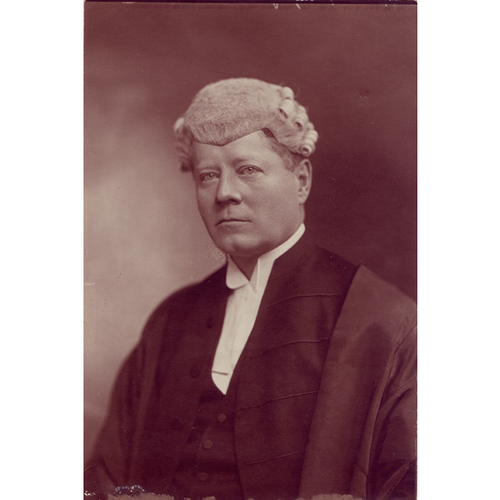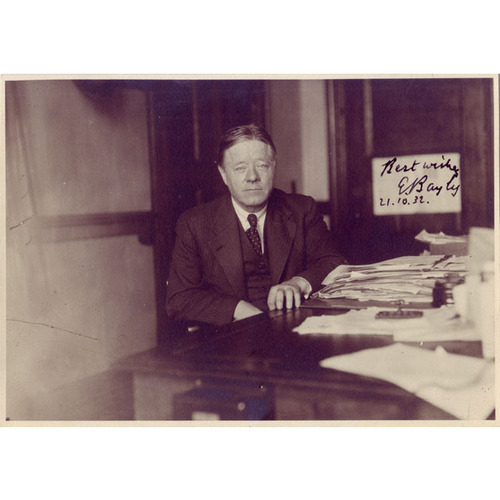![Portrait photograph of Edward Bayly (1865-1934). Date: [between 1910 and 1925]. Reference code: P411. Source: Archives of the Law Society of Upper Canada (https://www.flickr.com/photos/lsuc_archives/4427870584/in/photolist-7XwhoQ-7KgZEh-7FVyun-eM3EiT-jDiUzf-jDiVTN-nSf5oP/). Original title: Portrait photograph of Edward Bayly (1865-1934). Date: [between 1910 and 1925]. Reference code: P411. Source: Archives of the Law Society of Upper Canada (https://www.flickr.com/photos/lsuc_archives/4427870584/in/photolist-7XwhoQ-7KgZEh-7FVyun-eM3EiT-jDiUzf-jDiVTN-nSf5oP/).](/bioimages/w600.12852.jpg)
Source: Link
BAYLY, EDWARD (he sometimes used the middle initial J.), sportsman, lawyer, and civil servant; b. 25 Oct. 1865 in London, Upper Canada, son of William Bayly and Susan Jane Wilson; m. 27 Oct. 1909 Florence Myrtle Campbell in Toronto, and they had two sons; d. there 29 Jan. 1934.
Edward Bayly’s parents were both from prominent London families. His father was a merchant and manufacturer who had come to Canada from Ireland, where his family had formed part of the ruling Protestant minority. His mother was a daughter of John Wilson*, a lawyer, politician, and judge of the Court of Common Pleas who died in 1869, before Bayly really got to know his famous grandfather. Edward went to Trinity College School in Port Hope and then the University of Toronto (ba 1887). Admitted as a student to the Law Society of Upper Canada, he attended lectures at Osgoode Hall law school for the next three years and served as an articled clerk in the firm headed by Charles Moss*. He was called to the bar in 1890.
Bayly soon decided to confine himself to criminal-defence work. He returned to London and opened his own practice, but a lack of success there motivated him to move to Toronto in 1892, where he formed a partnership with two other young lawyers, Joseph Hughes and William Assheton Smith. Bayly was a fast learner with an excellent memory, and he soon had a good knowledge of the Criminal Code and case law. Still, he did not enjoy the prosperity he had hoped for; the firm of Bayly, Hughes and Smith lasted only two years. He next joined the firm of Fleury and Montgomery, and from 1896 to 1899 he served as an examiner at Osgoode Hall. In 1899 he returned to independent practice, but again he experienced difficulties. Two years later he tried another partnership, joining Edmund James Bristol* and William Herbert Cawthra to establish Bristol, Cawthra and Bayly. The following year Cawthra left and Eric Norman Armour joined the firm, which became Bristol, Bayly and Armour. In 1906 Bayly moved yet again, partnering with John William Seymour Corley and Percy G. Price in a firm known as Corley, Bayly, and Price.
Bayly’s failure to find early success as a lawyer, and his frequent changes of partners, may have been partly the result of his extensive and multifaceted career as an amateur athlete. Sports absorbed much of his time and energy. At university he was the captain of and star halfback on the rugby football team (another member was Edward Wentworth Beatty*), and even while studying law he played for Osgoode Hall. Although Bayly retired from the team upon launching his legal practice, he remained active in the game, first as a referee and later as president of both the Canadian Rugby Football Union and the Ontario Rugby Football Union. A skilled yachtsman, he belonged to the Royal Canadian Yacht Club, and in 1896 he crewed on the Canada, owned by Edward Æmilius Jarvis, when it won the Canada Cup in Toledo, Ohio. Bayly was also a talented horseman and a member of the Toronto Hunt Club, of which he served as secretary.
The 1906 partnership Bayly formed with J. W. S. Corley would indirectly shape the rest of his career. Corley had just been made the crown attorney for the City of Toronto, and he asked Bayly to assist him as a part-time crown counsel. Ontario’s deputy attorney general, John Robison Cartwright, soon noticed Bayly’s work and invited him in 1907 to join his staff as the first full-time solicitor to the office of the attorney general. The salary was $3,000, only $750 less than that of Cartwright himself, and Bayly jumped at this offer of a secure and substantial income. He was made a kc the next year and was primarily involved in special prosecutions and criminal-law appeals. In 1908, for example, he appeared for the crown in the Ontario Court of Appeal in R. v. Beboning and, in keeping with his belief that all individuals must be equal under the law, convinced the court that the Criminal Code applied to a case of theft on an indigenous reserve.
Providing advice on constitutional matters was an important responsibility of the attorney general’s office, and Bayly rapidly became a leading expert on constitutional law. He served as secretary to the 1909 interprovincial conference held in Toronto, and soon he was travelling frequently to Ottawa to assist in federal–provincial negotiations and to appear before the Supreme Court of Canada. He also made numerous trips to London, England, to argue constitutional appeals by the province before the Judicial Committee of the Privy Council. In 1919 he succeeded Cartwright as deputy attorney general, the position he would hold for the rest of his life.
Within the civil service Bayly became well known not only for his indispensable ability, but also for his many eccentricities. He was, according to the Toronto Daily Star, “noted as a conversationalist and could discourse at great length on an amazing range of subjects with authority”; colleagues recalled seeing him “in full sail,” telling all who would listen about his successes in rugby football and boating. He had a habit of tucking notes in the sweatband of his hat, and during walks around Queen’s Park, “whenever he doffed his hat to an acquaintance, bits of paper would flutter in his wake.” When Bayly encountered pedestrians while driving his big Pierce-Arrow (he was an avid motorist, and one of the first automobile owners in the city), he would stop, stand up, signal for them to cross, and bow grandly as they passed. He liked to ride a bicycle to work from his home on Madison Avenue in the city’s Annex district, and he could sometimes be found pedalling in circles around the “treasured walnut desk” in his office.
Bayly never enjoyed nor was very good at the administrative aspects of his office, and he preferred to leave such matters to his assistants, most notably Clifford Richard Magone, who would later become deputy attorney general. Bayly tended to ignore files that did not interest him, believing that “they usually solve themselves if you wait long enough.” He remained focused on special prosecutions, appeals, and constitutional cases, often appearing himself before the courts. The province’s laws and procedures were important to him, and in 1924 he joined a committee led by William Edward Middleton* that was charged with preparing the revised statutes of Ontario. This task involved reviewing all provincial acts for any inconsistencies as well as for clarity and readability, and it took three years to complete.
Bayly believed that businesses had the right to refuse service to individuals for any reason, including their skin colour, and he belonged to several private clubs with exclusively white membership. He maintained, however, that “the rights in this country of negroes are exactly the same as those of white people,” and he vigorously fought the Ku Klux Klan when it tried to establish itself in the province during the 1920s. Bayly got personally involved in the 1926 prosecution of KKK members who blew a hole in the wall of a Roman Catholic church in Barrie, and in that trial the attorney general’s office made it clear that “no group can take into its own hands the administration of the law.” He also convinced the Court of Appeal to uphold the conviction of a Klansman charged with “being disguised, by night, without lawful excuse.”
From 1926 to 1930 Bayly served a term as a bencher of the Law Society of Upper Canada, and in this capacity he participated in convocation, the society’s legislative arm. He was very disappointed not to be re-elected to the position in 1930. Undeterred, he inserted a clause in an omnibus amending bill that made the deputy attorney general an ex officio bencher. This provision was passed by the legislature, and Bayly was therefore able to remain active in the administration of the Law Society until his sudden death from a heart attack on 29 Jan. 1934. Eulogizing his friend and colleague, Attorney General William Herbert Price* remarked, “I do not think there was any man who read law more quickly and with a better grasp than Mr. Bayly,” and asserted that his deputy’s opinion had been “unassailable” on questions of criminal and constitutional law. “I never felt safe in going to Ottawa on a conference regarding matters of jurisdiction between the Dominion and the Province,” he recalled, “unless Mr. Bayly was with me.” It was an appropriate tribute to one of the most respected civil servants in Ontario during the early decades of the 20th century.
Law Soc. of Upper Can. Arch. (Toronto), 1-1-19 (Convocation fonds, minutes of convocation, pp.76–77); 1-5-5 (Convocation fonds, attorneys rolls 1849–1892 common pleas); 1-5-10 (Office of the secretary fonds, roll of practising barristers and solicitors). Globe, 30 Jan. 1934. Toronto Daily Star, 30 Jan. 1934. J. D. Arnup, Middleton: the beloved judge (Toronto, 1988). J. D. Ayre, “The crown attorneys of Ontario 1857–1957: a biographical survey” (unpublished ms, n.p., 2005; available at the Law Soc. of Upper Can. Arch.). Constance Backhouse, Colour-coded: a legal history of racism in Canada, 1900–1950 (Toronto and Buffalo, N.Y., 1999). The bench and bar of Ontario, ed. George Wilkie et al. (Toronto, 1905). L.‑R. Betcherman, The little band: the clashes between the communists and the political and legal establishment in Canada, 1928–1932 (Ottawa, 1982). Canadian Almanac … (Toronto), 1909, 1912. The Canadian law list (Toronto), 1895, 1900, 1905, 1910, 1915, 1920, 1925, 1930. Canadian men and women of the time (Morgan; 1912). John Honsberger, “Edward Bayly, k.c.,” Law Soc. of Upper Can., Gazette (Toronto), 11 (1977): 237–48. Barrington Walker, Race on trial: black defendants in Ontario’s criminal courts, 1858–1958 (Toronto and Buffalo, 2010). Who’s who and why, 1919/20.
Cite This Article
C. Ian Kyer, “BAYLY, EDWARD,” in Dictionary of Canadian Biography, vol. 16, University of Toronto/Université Laval, 2003–, accessed December 19, 2025, https://www.biographi.ca/en/bio/bayly_edward_16E.html.
The citation above shows the format for footnotes and endnotes according to the Chicago manual of style (16th edition). Information to be used in other citation formats:
| Permalink: | https://www.biographi.ca/en/bio/bayly_edward_16E.html |
| Author of Article: | C. Ian Kyer |
| Title of Article: | BAYLY, EDWARD |
| Publication Name: | Dictionary of Canadian Biography, vol. 16 |
| Publisher: | University of Toronto/Université Laval |
| Year of publication: | 2020 |
| Year of revision: | 2020 |
| Access Date: | December 19, 2025 |




